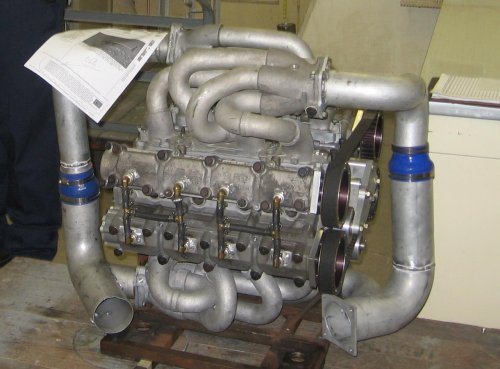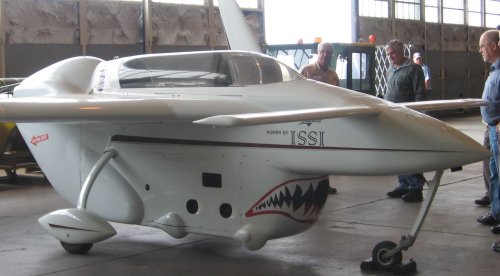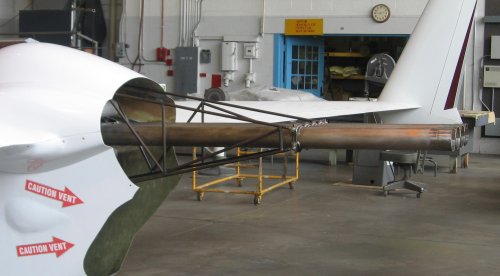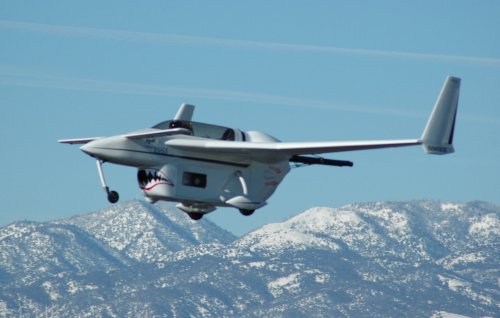You are using an out of date browser. It may not display this or other websites correctly.
You should upgrade or use an alternative browser.
You should upgrade or use an alternative browser.
PDE and Test Aircraft
- Thread starter elider
- Start date
That's just.... fugly. Ain't no other word for it.
- Joined
- 1 April 2006
- Messages
- 11,404
- Reaction score
- 10,365
I wonder if there's anywhere on the web *.wav with this baby sound?
Pulsed detonation engine flies into history
by Larine Barr
88th Air Base Wing Public Affairs
5/16/2008 - WRIGHT-PATTERSON AIR FORCE BASE, Ohio (AFPN) -- The engine that naysayers thought could never propel an aircraft across the sky is now at the National Museum of the U.S. Air Force, where it will be displayed this summer and remembered for its 2008 history-making flight.
The pulsed detonation engine, developed by a team from the Air Force Research Laboratory here, flew its record-breaking manned flight Jan. 31 at Mohave, Calif.
The pulsed detonation engine, or PDE, was flown on a modified Scaled Composites Long-EZ aircraft by test pilot Pete Siebold. He achieved a speed of over 120 mph and 60 to 100 feet altitude, which produced greater than 200 pounds of thrust. A jet assist takeoff was used to minimize takeoff roll and provide more runway margin, but was subsequently shut down when the PDE provided plenty of thrust for flight.
"The aircraft is in our restoration facility awaiting transfer for exhibit in our Experimental and Flight Test Gallery -- a most appropriate location for such a fine example of innovation," said Terry Aitken, the National Museum of the U.S. Air Force senior curator.
What makes the PDE so unique is instead of burning fuel, called deflagration, to get propulsion, air and fuel are mixed, ignited and detonated in controlled explosions inside open-ended tubes that look like exhaust pipes. When detonation moves through the tubes, it creates a supersonic shockwave that continually pulses and generates thrust.
The increased thrust could be capable of powering future aircraft up to speeds of Mach 4, or four times the speed of sound, and beyond. The PDE can be combined with other engine cycles, such as turbines, rockets, or hypersonic scramjets, to optimize flight envelopes, said Fred Schauer, assigned to the AFRL Propulsion Directorate.
"This engine offers the capability of static to near hypersonic flight with good supersonic efficiencies. Pulsed detonation engines could make sense for missions that require efficient supersonic cruise and/or boost from low to high speeds," Mr. Schauer said.
Another plus for the engine is its ability to run on a variety of fuels and maintain near-constant-volume combustion, which makes it highly fuel efficient.
"This is a potential game-changer in terms of fuel efficiency," Mr. Schauer said. "For comparison, if we had operated this same engine with conventional combustion we would have made less than a third of the thrust for the same fuel burn. In comparison to traditional engines, fuel savings of 5 to 20 percent could be expected."
These fuel efficiency savings are expected for typical propulsion applications if pulsed detonation technology can be integrated into conventional systems. Current research is directed toward realizing these benefits, Mr. Schauer said.
The primary goals of the proof of concept demonstration were to show that the experimental PDE could sustain an aircraft, withstand the extreme acoustic pressure during detonations, and prove that the noise level was not prohibitive for a pilot or those on the ground. Mr. Schauer said some of the biggest doubts about the PDE concerned survivability of an airframe and personnel.
Though the flight demonstration engine, made from off-the-shelf automotive parts, was designed in 2002, Mr. Schauer and his team worked over the years to refine the engine and developed a method to burn the fuel and air in a way that increased the intensity of the explosions.
A major drawback that kept the team from flying earlier was the excessive drag caused from all the accessories hanging under the aircraft.
"This was overcome by placing an aerodynamic cowling over the PDE, which was designed by Scaled Composites," Mr. Schauer said. "The engine also endured 100 hours of durability ground testing and 30 hours of airframe integration tests. "We never stopped working on pushing the technology."
The engine was developed and manufactured in-house by members of the AFRL Propulsion Directorate's Turbine Engine Division, Combustion Branch and its on-site contractor, ISSI. The successful flight test was a joint AFRL effort that included the activities of AFRL Propulsion Directorate for PDE developmental research and the propulsion package; AFRL Air Vehicles Directorate for structural, aero and acoustics; AFRL Human Effectiveness Directorate for exposure limits and acoustic protection, AFRL Materials and Manufacturing Directorate for structural materials; and Scaled Composites, Inc. for vehicle integration and flight testing.
The next steps for PDE are to develop systems that have the durability of the first engine, but with the performance of current innovations as well as hybrid turbine-based detonation cycles, Mr. Schauer said.
Pulsed detonation engine flies into history
by Larine Barr
88th Air Base Wing Public Affairs
5/16/2008 - WRIGHT-PATTERSON AIR FORCE BASE, Ohio (AFPN) -- The engine that naysayers thought could never propel an aircraft across the sky is now at the National Museum of the U.S. Air Force, where it will be displayed this summer and remembered for its 2008 history-making flight.
The pulsed detonation engine, developed by a team from the Air Force Research Laboratory here, flew its record-breaking manned flight Jan. 31 at Mohave, Calif.
The pulsed detonation engine, or PDE, was flown on a modified Scaled Composites Long-EZ aircraft by test pilot Pete Siebold. He achieved a speed of over 120 mph and 60 to 100 feet altitude, which produced greater than 200 pounds of thrust. A jet assist takeoff was used to minimize takeoff roll and provide more runway margin, but was subsequently shut down when the PDE provided plenty of thrust for flight.
"The aircraft is in our restoration facility awaiting transfer for exhibit in our Experimental and Flight Test Gallery -- a most appropriate location for such a fine example of innovation," said Terry Aitken, the National Museum of the U.S. Air Force senior curator.
What makes the PDE so unique is instead of burning fuel, called deflagration, to get propulsion, air and fuel are mixed, ignited and detonated in controlled explosions inside open-ended tubes that look like exhaust pipes. When detonation moves through the tubes, it creates a supersonic shockwave that continually pulses and generates thrust.
The increased thrust could be capable of powering future aircraft up to speeds of Mach 4, or four times the speed of sound, and beyond. The PDE can be combined with other engine cycles, such as turbines, rockets, or hypersonic scramjets, to optimize flight envelopes, said Fred Schauer, assigned to the AFRL Propulsion Directorate.
"This engine offers the capability of static to near hypersonic flight with good supersonic efficiencies. Pulsed detonation engines could make sense for missions that require efficient supersonic cruise and/or boost from low to high speeds," Mr. Schauer said.
Another plus for the engine is its ability to run on a variety of fuels and maintain near-constant-volume combustion, which makes it highly fuel efficient.
"This is a potential game-changer in terms of fuel efficiency," Mr. Schauer said. "For comparison, if we had operated this same engine with conventional combustion we would have made less than a third of the thrust for the same fuel burn. In comparison to traditional engines, fuel savings of 5 to 20 percent could be expected."
These fuel efficiency savings are expected for typical propulsion applications if pulsed detonation technology can be integrated into conventional systems. Current research is directed toward realizing these benefits, Mr. Schauer said.
The primary goals of the proof of concept demonstration were to show that the experimental PDE could sustain an aircraft, withstand the extreme acoustic pressure during detonations, and prove that the noise level was not prohibitive for a pilot or those on the ground. Mr. Schauer said some of the biggest doubts about the PDE concerned survivability of an airframe and personnel.
Though the flight demonstration engine, made from off-the-shelf automotive parts, was designed in 2002, Mr. Schauer and his team worked over the years to refine the engine and developed a method to burn the fuel and air in a way that increased the intensity of the explosions.
A major drawback that kept the team from flying earlier was the excessive drag caused from all the accessories hanging under the aircraft.
"This was overcome by placing an aerodynamic cowling over the PDE, which was designed by Scaled Composites," Mr. Schauer said. "The engine also endured 100 hours of durability ground testing and 30 hours of airframe integration tests. "We never stopped working on pushing the technology."
The engine was developed and manufactured in-house by members of the AFRL Propulsion Directorate's Turbine Engine Division, Combustion Branch and its on-site contractor, ISSI. The successful flight test was a joint AFRL effort that included the activities of AFRL Propulsion Directorate for PDE developmental research and the propulsion package; AFRL Air Vehicles Directorate for structural, aero and acoustics; AFRL Human Effectiveness Directorate for exposure limits and acoustic protection, AFRL Materials and Manufacturing Directorate for structural materials; and Scaled Composites, Inc. for vehicle integration and flight testing.
The next steps for PDE are to develop systems that have the durability of the first engine, but with the performance of current innovations as well as hybrid turbine-based detonation cycles, Mr. Schauer said.
Attachments
- Joined
- 9 October 2009
- Messages
- 22,012
- Reaction score
- 13,695
Similar threads
-
-
-
Bell Model 206L « TexasRanger » gunship
- Started by RavenOne
- Replies: 8
-
Bianchi Survey Light Aircraft Project of 1950
- Started by hesham
- Replies: 0
-




